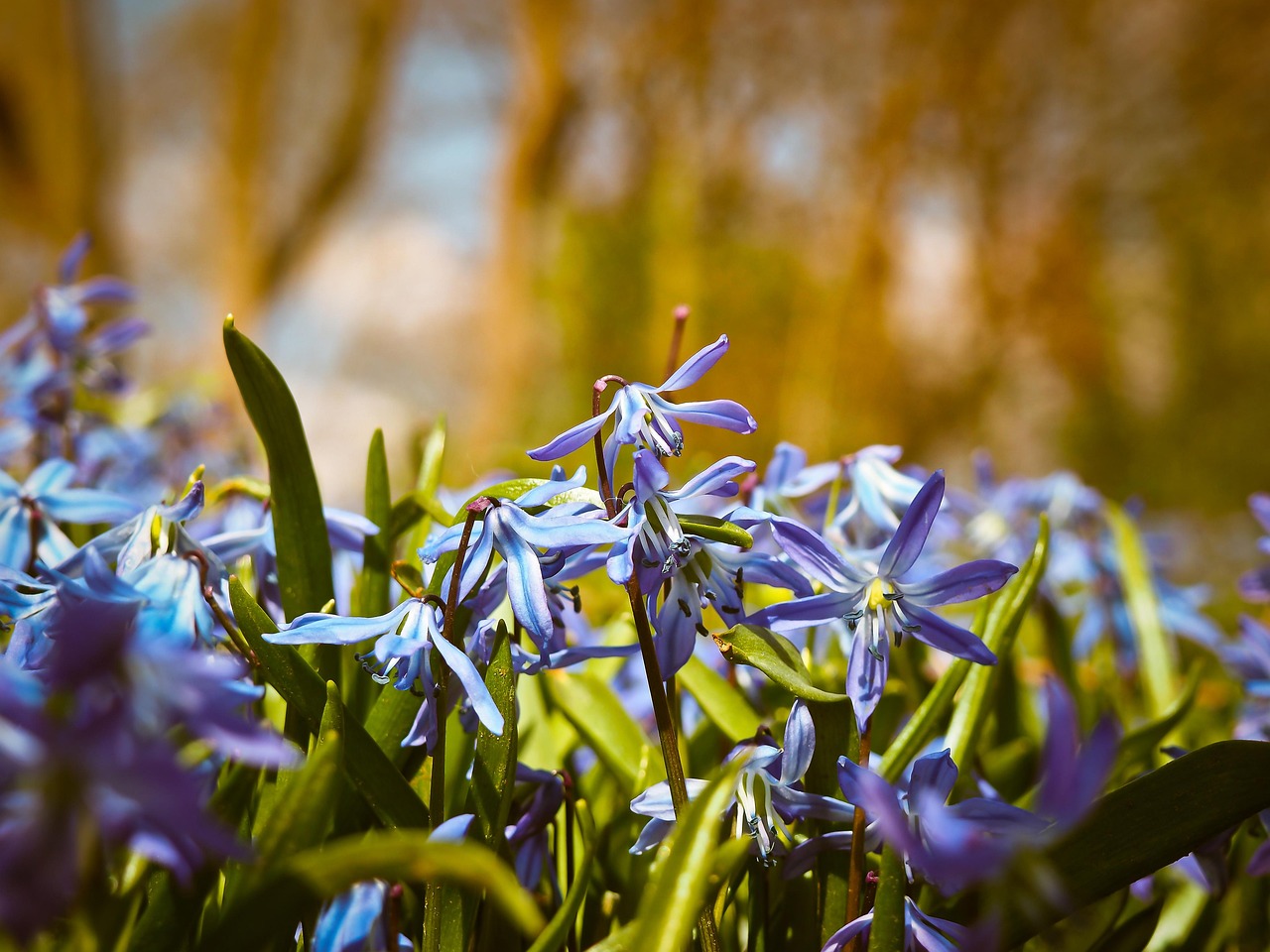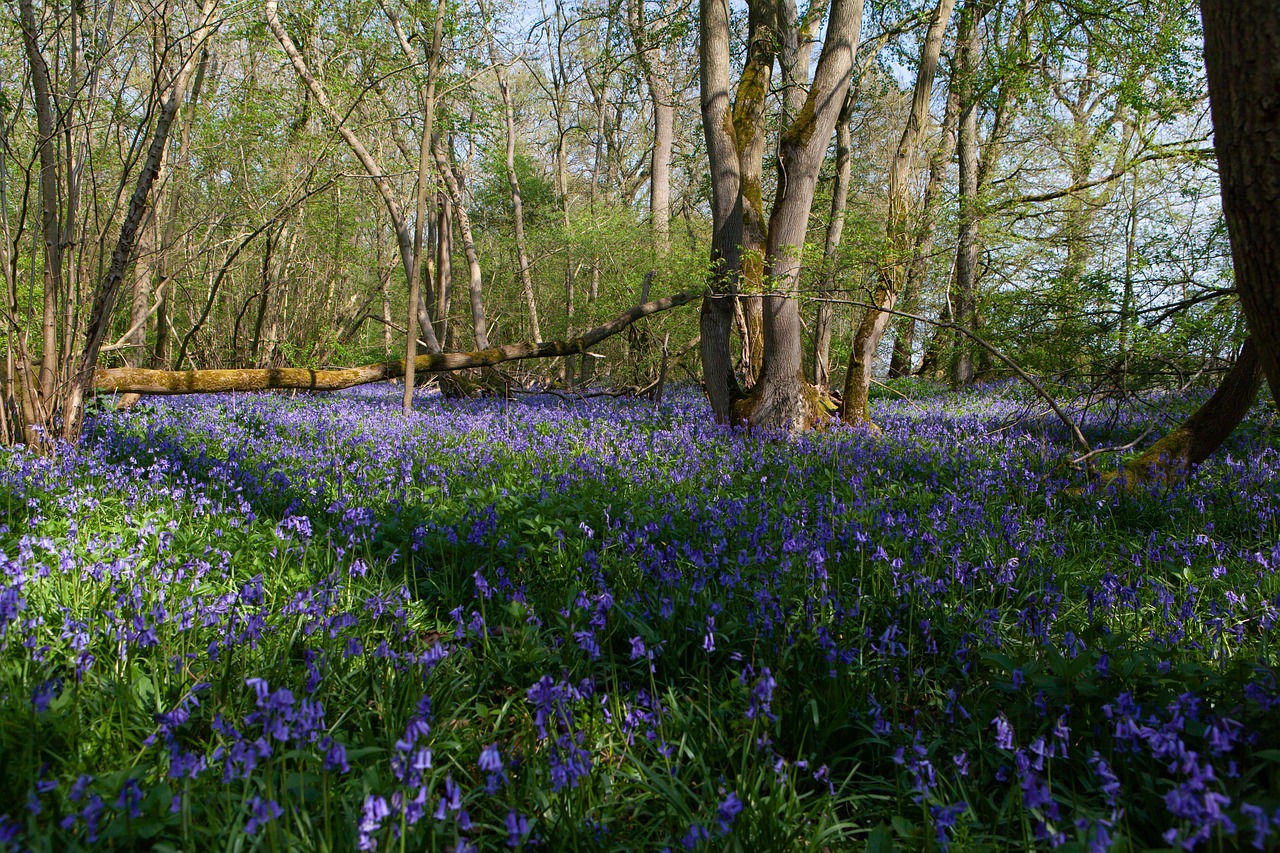Bluebell flowers are captivating woodland plants known for their stunning blue blooms and delicate fragrance. These enchanting flowers not only enhance the beauty of gardens but also thrive in natural woodland settings, making them a wonderful addition to any landscape.
Belonging to the Hyacinthaceae family, bluebells are native to Europe and are particularly famous in the United Kingdom. Their vibrant colors and sweet scent attract various pollinators, including bees and butterflies. The sight of a bluebell carpet in full bloom is a breathtaking experience that many garden enthusiasts strive to replicate in their own yards.

Bluebells typically bloom in spring, creating a beautiful display of color that signals the end of winter. They can grow in various conditions but prefer shaded areas with moist, well-drained soil. This makes them ideal for planting under trees or in woodland gardens.
There are several species of bluebells, with the two most common being:
- Common Bluebell (Hyacinthoides non-scripta): This species features deep blue, bell-shaped flowers that droop to one side. It is the most prevalent bluebell in the UK.
- Spanish Bluebell (Hyacinthoides hispanica): This variety is often larger and has a more upright flower spike. It is typically seen in gardens and can sometimes hybridize with the common bluebell.
Growing Bluebell Flowers
Growing bluebells can be a rewarding endeavor for any gardener. These flowers are relatively easy to cultivate, provided their specific needs are met. Here are some key factors to consider when growing bluebells:
| Aspect | Details |
|---|---|
| Soil Type | Moist, well-drained soil rich in organic matter. |
| Light Requirements | Partial to full shade; they thrive under tree canopies. |
| Watering | Regular watering during dry spells; do not overwater. |
| Planting Time | Best planted in autumn or early spring. |
When planting bluebell bulbs, it is essential to space them adequately to allow for natural spreading. Typically, planting them about 4 to 6 inches apart will enable them to flourish without overcrowding. Once established, bluebells can spread and create a stunning display over the years.
These flowers are also known for their resilience. Once they are established, they can survive in various conditions, making them suitable for different garden environments. However, keep in mind that bluebells may take a few seasons to fully settle in and begin flowering profusely.
In addition to their aesthetic appeal, bluebells play a significant role in supporting local ecosystems. Their blooms provide essential nectar and pollen for early-season pollinators, making them an important part of woodland biodiversity. By growing bluebells, you are not only enhancing your garden’s beauty but also contributing to the health of your local environment.
Whether you choose to plant them in large clusters or incorporate them into existing garden beds, bluebells are sure to bring charm and elegance to your outdoor space. Their enchanting presence will transform any area into a serene woodland oasis.
Care and Maintenance of Bluebell Flowers
Caring for bluebell flowers is essential to ensure they thrive and produce stunning blooms. While these plants are relatively low-maintenance, there are several practices that can enhance their growth and longevity. Here are some key aspects to consider when maintaining your bluebells:
Watering Practices
Bluebells require consistent moisture, especially during their growing season in spring. However, overwatering can lead to bulb rot. It is crucial to strike a balance. Here are some tips for effective watering:
- Water deeply but infrequently to encourage deep root growth.
- Avoid watering during prolonged wet periods, as bluebells prefer slightly drier conditions once they have finished blooming.
- Monitor the soil moisture and adjust your watering schedule accordingly.
Fertilizing
While bluebells do not require heavy fertilization, providing them with a nutrient boost can promote healthier growth. Consider the following:
- Apply a balanced, slow-release fertilizer in early spring when new growth appears.
- A light application of compost or well-rotted manure can enhance soil fertility.
- Avoid excessive nitrogen, as it may lead to lush foliage at the expense of flowering.
Pruning and Deadheading
Pruning bluebells helps maintain their health and appearance. Here are some practices to keep in mind:
- After the flowers fade, allow the foliage to die back naturally. This process helps the bulbs store energy for the next growing season.
- You can remove any dead or yellowing leaves to tidy up the area.
- Deadheading (removing spent flowers) can prevent unwanted seed spread if you want to control their growth.
Pest and Disease Management

Bluebells are generally resilient but can be vulnerable to certain pests and diseases. Being aware of potential issues can help you manage them effectively:
Pests
The most common pests affecting bluebells include:
- Aphids: These sap-sucking insects can weaken plants. Remove them by washing with water or using insecticidal soap.
- Snails and slugs: They may feast on young foliage. Consider using organic baits or barriers to deter them.
Diseases
Bluebells are susceptible to fungal infections, particularly in overly damp conditions. Here are some preventive measures:
- Avoid overcrowding when planting to ensure good air circulation.
- Water at the base of plants rather than overhead to reduce humidity around leaves.
Companion Planting with Bluebells

Integrating bluebells with other plants can enhance the beauty of your garden while promoting biodiversity. Here are some ideal companion plants:

- Woodland Ferns: Their delicate fronds complement bluebells and thrive in similar shady conditions.
- Hostas: These leafy plants provide a lush background for bluebells and enjoy moist, shaded areas.
- Primroses: Their bright flowers create a vibrant contrast with bluebells during springtime.
By carefully selecting companion plants, you can create a harmonious and visually appealing garden space that celebrates the enchanting beauty of bluebell flowers.
Harvesting and Propagating Bluebell Flowers
Harvesting and propagating bluebells can be a delightful way to expand your garden or share these enchanting flowers with friends. Understanding how to do this properly will ensure you maintain the health of your plants while enjoying their beauty.
Harvesting Bluebell Flowers
Though bluebells are primarily grown for their stunning blooms, they can also be harvested for floral arrangements. Here are some tips for harvesting bluebells responsibly:
- Choose a dry day to cut flowers, as moisture can lead to mold during storage.
- Use sharp scissors or pruning shears to make clean cuts just above the foliage.
- Limit harvesting to a few flowers from each plant to ensure they can continue to thrive.
When creating arrangements, consider combining bluebells with other spring flowers for a vibrant display. Their delicate shape and color make them an attractive addition to any bouquet.
Propagating Bluebell Flowers
Bluebells can be propagated through seeds or by dividing established bulbs. Each method has its advantages and can lead to beautiful new plants in your garden.
Seed Propagation
Seed propagation is a slower method but can be rewarding. Here are the steps:
- Collect seeds after the flowers have faded and the seed pods have dried.
- Sow the seeds in well-draining soil in late autumn or early spring.
- Keep the soil moist until seedlings establish, which may take several months.
- Once seedlings are large enough, transplant them to their permanent location.
Bulb Division
Dividing bluebell bulbs is a quicker method for propagation. Follow these steps:
- Wait until late summer when the foliage has died back naturally.
- Carefully dig up the bulbs, taking care not to damage them.
- Separate the bulbs, ensuring each division has roots attached.
- Replant immediately at the same depth in well-draining soil.
This method not only increases your bluebell population but also helps rejuvenate older plants that may be overcrowded.
Cultural Significance of Bluebells
The cultural significance of bluebells extends beyond their beauty. These flowers hold symbolic meanings in various cultures and are often associated with folklore and traditions.
Folklore and Legends
In many cultures, bluebells are linked to myths and legends. Here are some notable associations:
- Fairy Flowers: In English folklore, bluebells are thought to be associated with fairies. It is said that if you hear their bells ringing, it means that fairies are nearby.
- Symbol of Humility: Bluebells are often seen as symbols of humility and gratitude due to their gentle appearance and growth in woodland settings.
Environmental Importance
Beyond their aesthetic and cultural value, bluebells play a crucial role in the ecosystem. They provide vital resources for pollinators during early spring when few other flowers are blooming. Their presence contributes to the overall health of woodland habitats and supports a variety of wildlife.
By planting bluebells, gardeners can help preserve these important species and promote biodiversity in their local environments. Their enchanting beauty is just one aspect of what makes bluebells so special, both in gardens and in nature.
Challenges and Considerations for Growing Bluebells
While bluebells are enchanting additions to any garden, they do come with certain challenges that gardeners should be aware of. Understanding these challenges can help ensure successful cultivation and maintenance of these beautiful flowers.
Invasive Species Concerns
One of the primary challenges related to bluebells, especially the Spanish bluebell (Hyacinthoides hispanica), is its invasive nature. This species can hybridize with the native common bluebell (Hyacinthoides non-scripta), leading to concerns about the preservation of native populations. Here are some considerations:
- Monitor your bluebell populations regularly to prevent hybrids from overtaking native species.
- If planting Spanish bluebells, consider keeping them in contained spaces or pots to minimize their spread.
- Educate yourself on identifying the differences between native and non-native species to help protect local biodiversity.
Climate and Soil Adaptability
Bluebells thrive best in specific climate conditions and soil types. While they are adaptable to some extent, it is essential to ensure that your local environment meets their needs:
- Bluebells prefer temperate climates with mild winters and cool summers. Extreme heat can stress the plants.
- They thrive in well-drained soil rich in organic matter. If your soil is sandy or clay-heavy, consider amending it before planting.
- In hotter regions, providing partial shade can help protect bluebells from excessive heat.
Final Thoughts
Bluebell flowers are truly enchanting woodland beauties that bring charm and elegance to gardens. Their delicate blooms and sweet fragrance not only enhance the visual appeal of outdoor spaces but also contribute significantly to local ecosystems. By understanding their growth requirements, proper care, and potential challenges, gardeners can successfully cultivate these captivating plants.
From their fascinating folklore connections to their vital role in supporting pollinators, bluebells hold a special place in both nature and culture. Whether planted in clusters under trees or integrated into mixed flower beds, they create a serene and magical atmosphere that many gardeners cherish.
As we embrace the beauty of bluebells, let us also recognize our responsibility to protect native species and promote biodiversity within our gardens. By choosing to grow bluebells thoughtfully, we not only create stunning displays but also foster a healthier environment for wildlife and future generations.
In conclusion, bluebells are more than just flowers; they are a vital part of our natural heritage. By cultivating them with care and respect, we contribute to a vibrant ecosystem while enjoying the enchanting beauty they provide each spring.
